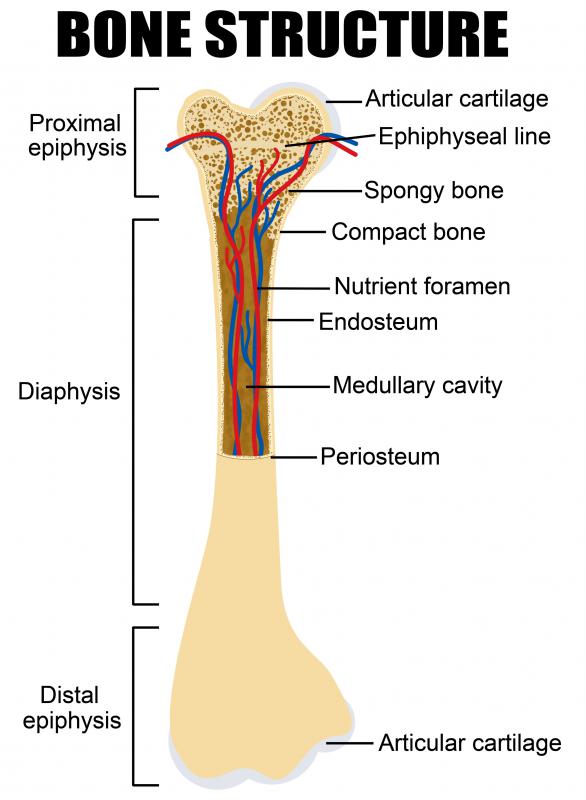At WiseGEEK, we're committed to delivering accurate, trustworthy information. Our expert-authored content is rigorously fact-checked and sourced from credible authorities. Discover how we uphold the highest standards in providing you with reliable knowledge.
How Do I Recognize the Symptoms of Bone Cancer?
Bone cancer, or primary bone cancer, is a rare tumor that forms in any of the bones in the body. Pain is the most common symptom of bone cancer. Other symptoms of bone cancer may include swelling, fatigue, and fever. Doctors use multiple scans and tests to confirm a diagnosis because bone cancer symptoms resemble those of other medical conditions. Treatment of the symptoms generally depends on the type of bone cancer.
According to medical sources, symptoms of bone cancer most often affect children and young adults. Bone cancer can develop in any of the 206 bones of the body, but they commonly form in the longer bones found in the arms and legs. Both benign and malignant tumors grow and crowd around healthy bone tissues. Unlike benign tumors, malignant bone cancer damages surrounding bone tissue and spreads to other parts of the body.

Persistent, sharp pain is one of the common symptoms of bone cancer, followed by other difficulties. The cancerous tumor can weaken the bones and cause fractures that lead to the pain, which worsens at night. The spread of the tumor itself also causes pain within the bones because it compresses against other bone tissues. You must seek medical evaluation as soon as possible if pain in the area of the joint or limb interferes with your daily life. The pain may indicate bone cancer or another condition that causes similar symptoms.

Other symptoms of bone cancer include swelling or stiffness at the site of the bone, interfering with normal joint movement. Bone cancer destroys healthy cells and forms abnormal cells that cause tumors. Tumors that form at or near the bone joints often cause swelling. If a fever accompanies the discomfort, then that may indicate bone cancer.
Fatigue is also another symptom of bone, as well as other, cancers. According to medical sources, the fatigue may come from the cancer that attacks your body or from side effects of cancer treatment. Other underlying factors that cause tiredness may include pain that disrupts your sleep. Lack of nutrition may also contribute to the fatigue because cancer symptoms can affect your appetite, which in turn contributes to unexplained weight loss. Anemia may be another symptom of bone cancer if the tumor has spread to the bone marrow, interfering with your blood cell count.

Primary bone cancer falls into a few different categories that occur depending on the person’s age and the location of the tumor. Chondrasarcoma occurs when a tumor forms in the cartilage cells in areas such as the shoulder, upper leg, and pelvis. Osteosarcoma develops in the bone cells found in the arms and knees, while Ewing’s sarcoma reportedly starts in the nerve tissues usually found on the backbone, pelvis, or in the blood vessels. Chondrasarcoma is said to occur mostly in adults age 40 and up. Ewing’s sarcoma and osteosarcoma, however, can develop in children and adults.

If you experience any of the symptoms of bone cancer, consulting your family doctor would be the first step. You will likely get a referral to a cancer specialist known as an oncologist, who will order a series of tests to confirm symptoms of bone cancer. Imaging tests, such as an X-ray and a positron emission tomography (PET) scan, detect tumors and other abnormalities. The doctor may also test your blood for high levels of alkaline phosphatase, an enzyme that becomes active when bones grow or mend. The lab test also checks for abnormal bone tissues that may indicate cancer.

A biopsy involves taking a sample of bone tissue to examine it for cancer. If all of the tests confirm a diagnosis of bone cancer, treatment options include surgery, chemotherapy, radiation, and cryosurgery. During surgery, the doctor removes the entire tumor, which sometimes may involve removing an entire limb. Patients who choose chemotherapy must take anticancer drugs, while radiation therapy uses X-rays to kill cancer cells. In cryosurgery, the doctor freezes and kills cancerous cells with the help of liquid nitrogen.
AS FEATURED ON:
AS FEATURED ON:















Discuss this Article
Post your comments